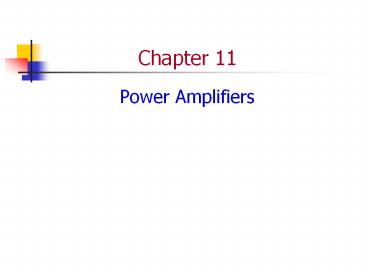Power Amplifiers - PowerPoint PPT Presentation
1 / 30
Title:
Power Amplifiers
Description:
Chapter 11 Power Amplifiers Amplifier Efficiency The ideal amplifier would be 100% efficient. The lower the Q-point position on the dc load line, the higher its ... – PowerPoint PPT presentation
Number of Views:3763
Avg rating:3.0/5.0
Title: Power Amplifiers
1
Chapter 11
- Power Amplifiers
2
Amplifier Efficiency
- The ideal amplifier would be 100 efficient.
- The lower the Q-point position on the dc load
line, the higher its efficiency. Class A is the
least efficient. Class C is the most efficient.
3
The AC Load Line
- AC load line A graph of all possible
combinations of ic and vce for a given amplifier. - The ac load line for a given amplifier does not
normally match its dc load line.
4
AC Load Line Endpoints
- The ac values of collector saturation current and
collector-emitter cutoff voltage are calculated
using Q-point circuit values.
5
Compliance (PP)
- Compliance The limit that the output circuit of
an amplifier places on its peak-to-peak output
voltage. - A measure of a circuits ability to comply with
the demands of its load.
6
Clipping
- Saturation clipping A type of distortion caused
by driving a transistor into saturation. - Cutoff clipping A type of distortion caused by
driving a transistor into cutoff.
7
Class A Amplifier DC Power
- Total DC power equals the product of supply
voltage and current.
8
AC Load Power
- Using rms load voltage
- Using peak load voltage
- Using peak-to-peak load voltage
- Maximum load power
9
Transformer-Coupled Class A Amplifier
- This type of amplifier uses a transformer to
couple the output signal to its load.
10
AC Operating Characteristics
- The value of vce(off) for a transformer-coupled
class A amplifier is nearly twice the value of
VCC. - The maximum theoretical efficiency for this type
of amplifier is 50.
11
Class B Amplifiers
- Contain two transistors. These transistors are
matched or complementary, depending on the
circuit configuration. - Complementary transistors are npn and pnp
transistors with identical characteristics. - Have a maximum theoretical efficiency of nearly
78.5.
12
Complementary-Symmetry Class B Amplifier
- Also referred to as a push-pull emitter follower.
- The circuit contains complementary transistors
that are connected as shown.
13
Class B Operation Overview
- The transistors conduct during alternating
half-cycles of the input signal.
14
Crossover Distortion
- Crossover distortion Distortion caused by class
B transistor biasing. It occurs during the time
neither of the transistors is fully conducting.
15
DC Biasing Characteristics
- The class B amplifier has a vertical dc load
line. - The transistors are biased in cutoff.
- The transistors have equal values of VCEQ.
16
AC Load Line
17
Circuit Gain and Impedances
- The complementary-symmetry amplifier is an
emitter follower, so the gain and impedance
relationships are similar to those for a class A
emitter follower.
18
Power Calculations
19
Diode Bias
- Diode Bias A biasing circuit that uses two
diodes in place of the resistor between the bases
of the two transistors. - Diode bias prevents crossover distortion and
thermal runaway.
20
Diode Bias DC Characteristics
- The transistors are biased just above cutoff.
- VCEQ for each transistor is half the value of
VCC. - The voltage across the diode pair is
approximately 1.4 V. - The resistor currents (I1 and I2) are equal.
21
Circuit Currents
22
Class AB Operation
- Each transistor in a class AB amplifier conducts
for more than 180 and less than 360 of the
input signal cycle. - Class AB operation prevents crossover distortion.
23
Preventing Thermal Runaway
- The diodes in the class AB amplifier prevent
thermal runaway when they are in thermal contact
with the transistors. - Thermal contact Two or more components placed
in physical contact with each other (or a common
surface) so that their operating temperatures are
equal. - Thermal contact can be achieved by attaching a
diode to - The heat-sink tab on a power transistor.
- The heat sink on which a transistor is mounted.
24
Single-Capacitor Input
25
Transistor-Driver Input
26
Darlington Class AB Amplifier
27
Transistor Biasing
28
Dual-Polarity Class AB Amplifier
29
Maximum Transistor Power
- The maximum power dissipated by the transistor in
a class A amplifier is found using
- The maximum power dissipated by each transistor
in a class B (or class AB) amplifier is found
using
30
Heat Sinks
- Heat sink A large metallic object that helps to
cool components by increasing their effective
surface area. - Heat sink compound is a compound used to aid in
the transfer of heat from a component to a heat
sink.































